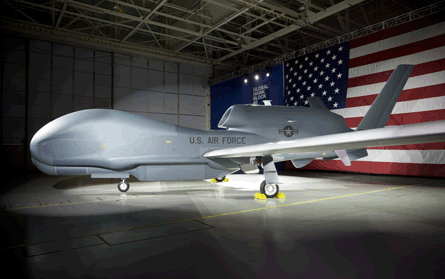Northrop Grumman has started working out details of a plan to boost the commonality between the US Air Force RQ-4 Global Hawk family and the US Navy's Broad Area Maritime Surveillance fleet.
Changes could include blending navy-funded improvements into the unmanned aircraft system's ground control station and flight safety features, with the services sharing a manufacturing line for the high-altitude, long-endurance type.
Two years after the navy chose a modified RQ-4 for the $9 billion BAMS requirement, Northrop's two biggest customers want to make the programme as "joint" as possible.
"It's clear there are commonality and synergy opportunities across the services and across the international programmes," says Steven Enewold, vice-president of Northrop's BAMS programme.
 |
|---|
© Northrop Grumman |
The USN now plans to buy 70 BAMS aircraft for $12.5 billion, augmenting about 117 manned Boeing 737-based P-8A Poseidons. The air force will invest $13.7 billion to purchase 77 RQ-4s, including 23 additional aircraft announced recently.
"Gary and I are committed to not having more differences between these platforms than is truly necessary," says USAF chief of staff Gen Norton Schwartz, referring to chief of naval operations Adm Gary Roughead.
The first target of the commonality push is the air force's version of the Global Hawk's Raytheon ground control station. This is housed in a shelter, but the navy is enclosing a separately designed control system in a building. "We're working really hard to make sure those systems are compatible, if not identical," Enewold says.
The navy has also invested in increased safety features for the Global Hawk airframe, as its BAMS fleet will be required to rapidly descend to low altitude to positively identify ships spotted on radar. Its aircraft has a strengthened wing and anti-icing systems installed in the wing leading edges and vertical tails.
"There are a lot of things that are kind of like the next step in the history and the evolution of the programme," Enewold says, "and I'm giving those things back to [the air force] to see what could be the appropriate thing."
The USAF, meanwhile, may be having second thoughts about the Block 40 Global Hawk's multi-platform radar technology insertion programme sensor. The service has launched a "quick-look study", asking industry whether a more affordable synthetic aperture radar with ground moving target indicator capability could be available within 24-36 months.
The study is unlikely to focus on Northrop's multi-function active sensor payload selected for the navy, as Schwartz has said he expects the Global Hawk and BAMS platforms to always operate different sensors due to the latter's focus on maritime surveillance tasks.
Northrop vice-president of HALE systems George Guerra believes the new study could be related to a separate effort to develop a future sensor payload for the RQ-4.
Source: Flight International
















